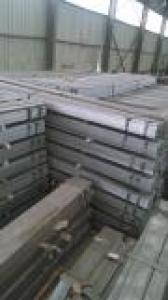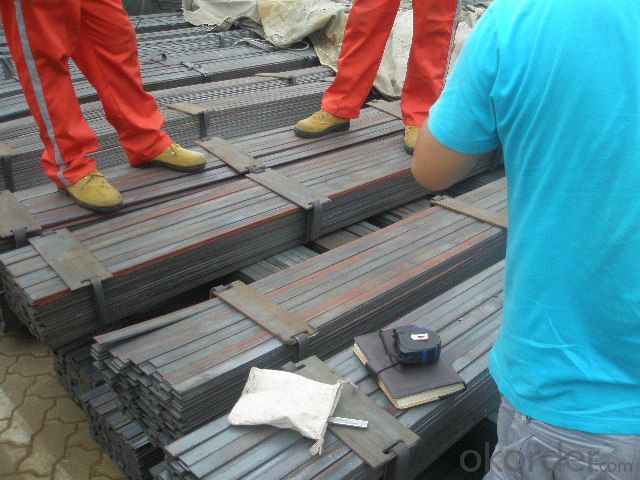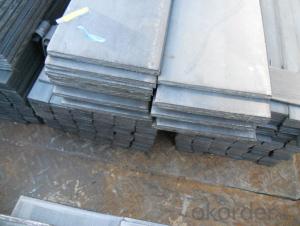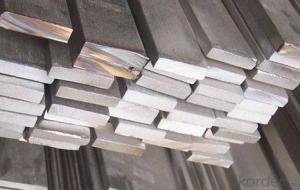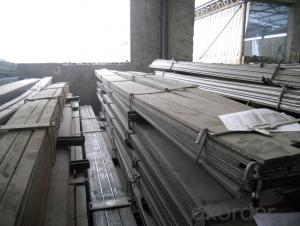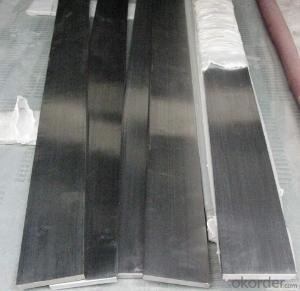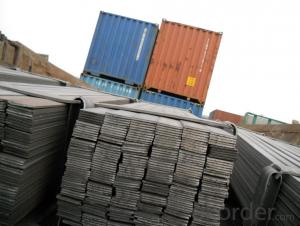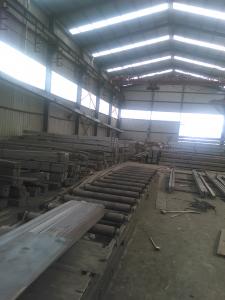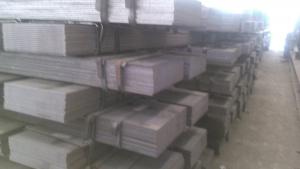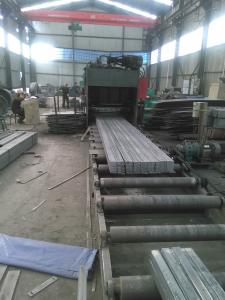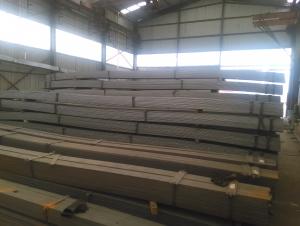Steel Flat Bar GB 235
- Loading Port:
- China Main Port
- Payment Terms:
- TT or LC
- Min Order Qty:
- -
- Supply Capability:
- -
OKorder Service Pledge
OKorder Financial Service
You Might Also Like
Product Description:
OKorder is offering Steel Flat Bar GB 235 at great prices with worldwide shipping. Our supplier is a world-class manufacturer of steel, with our products utilized the world over. OKorder annually supplies products to European, North American and Asian markets. We provide quotations within 24 hours of receiving an inquiry and guarantee competitive prices.
Product Applications:
Steel Flat Bar GB 235 are ideal for structural applications and are widely used in the construction of buildings and bridges, and the manufacturing, petrochemical, and transportation industries.
Product Advantages:
OKorder's Steel Flat Bar GB 235 are durable, strong, and resist corrosion.
Main Product Features:
· Premium quality
· Prompt delivery & seaworthy packing (30 days after receiving deposit)
· Corrosion resistance
· Can be recycled and reused
· Mill test certification
· Professional Service
· Competitive pricing
Product Specifications:
Standard: GB
Material: Q235
Origin place: China
Thickness: 3mm-30mm
Width:20mm-200mm
Length: Max 12m
Widely used for construction, Machinery manufacturing, Iron tower steel structure, Shipbuilding; Steel grating, Staircase, Bridge, Viaduct, Railway spare parts, Boilers making etc.
The steel flat bar is made through three processes:
1.Feeding the material: Feeding the row material (the steel plate) to Slitting Line.
2.Slitting:The steel plate would be slitted into expected width by lengthways cutter.
3. Leveled and cutting: The plat bar would be ground into level by the grinder and then cut into required length.
Packaging Details: The Steel Flat Bars are packed in bundles and loaded in 20 feet/40 feet container, or shipped by bulk cargo ,also we can do as customer's requirements.
FAQ:
Q1: Why buy Materials & Equipment from OKorder.com?
A1: All products offered byOKorder.com are carefully selected from China's most reliable manufacturing enterprises. Through its ISO certifications, OKorder.com adheres to the highest standards and a commitment to supply chain safety and customer satisfaction.
Q2: How do we guarantee the quality of our products?
A2: We have established an advanced quality management system which conducts strict quality tests at every step, from raw materials to the final product. At the same time, we provide extensive follow-up service assurances as required.
Q3: How soon can we receive the product after purchase?
A3: Within three days of placing an order, we will begin production. The specific shipping date is dependent upon international and government factors, but is typically 7 to 10 workdays.
Images:
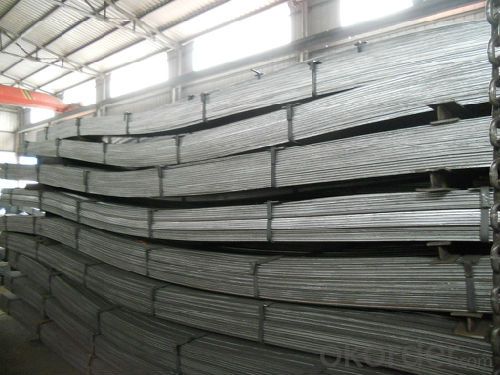
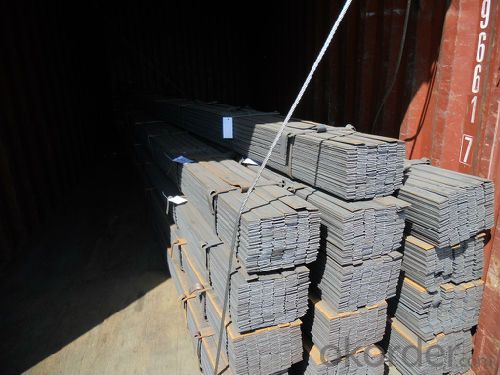
- Q: Are steel flat bars resistant to chemical exposure?
- Steel flat bars are generally resistant to chemical exposure. Steel is known for its durability and strength, making it resistant to many chemicals. However, the level of resistance can vary depending on the specific type of steel and the chemicals it is exposed to. Corrosion can occur if the steel is exposed to certain corrosive chemicals such as acids or alkalis. In such cases, it is advisable to use stainless steel flat bars which have an added layer of protection against corrosion. Additionally, the duration and concentration of the chemical exposure can also affect the steel's resistance. Taking proper precautions and regular maintenance can help prolong the lifespan of steel flat bars even in chemically exposed environments.
- Q: What are the standard lengths available for steel flat bars?
- The standard lengths available for steel flat bars typically range from 6 feet to 20 feet.
- Q: Are steel flat bars suitable for high-traffic areas?
- Yes, steel flat bars are suitable for high-traffic areas. Due to their durability and strength, steel flat bars can withstand heavy foot traffic and the constant movement of people without getting easily damaged or worn out. They are resistant to impact and can handle the weight and pressure exerted by individuals walking or running on them. Additionally, steel flat bars are commonly used in industrial and commercial settings precisely because they are designed to withstand high traffic and heavy loads. Their sturdy construction and ability to handle constant use make them an ideal choice for areas such as walkways, staircases, platforms, and other high-traffic zones.
- Q: How can copper cables and flat steel be welded together?
- As a thin strip of copper or copper brazing Hanbian flat, the flat copper or steel crimping brazed or welded to the ground flat strip. Not copper brazing, tin soldered or crimped copper braid, then copper tape terminal is connected to the flat.
- Q: How do you prevent rusting on steel flat bars?
- To prevent rusting on steel flat bars, there are several steps you can take: 1. Keep the bars dry: Moisture is a major contributor to rusting. Ensure that the flat bars are stored in a dry environment and avoid exposing them to water or excessive humidity. 2. Apply a protective coating: Applying a protective coating is an effective way to prevent rust formation. Options include paint, varnish, or a specialized rust-resistant coating. Make sure to choose a coating that is specifically designed for steel and can withstand the intended use of the flat bars. 3. Use galvanized steel: Galvanization is a process that involves coating steel with a layer of zinc. This protective layer acts as a barrier against moisture and prevents rusting. Galvanized steel flat bars are highly resistant to corrosion and can be a great choice if rust prevention is a priority. 4. Maintain proper ventilation: If the steel flat bars are used in an environment with high humidity or exposure to chemicals, adequate ventilation is crucial. Proper airflow helps to prevent the accumulation of moisture, reducing the risk of rust formation. 5. Regular cleaning and inspection: Regularly cleaning the steel flat bars and inspecting them for any signs of rust or damage is essential. If any rust spots are detected, they should be promptly addressed to prevent further corrosion. 6. Store the bars properly: When storing steel flat bars, ensure they are kept in a dry location away from any potential sources of moisture. Consider using storage racks or shelves to prevent direct contact with the ground or other surfaces that may accumulate moisture. By following these preventive measures, you can significantly reduce the chances of rusting on steel flat bars and prolong their lifespan.
- Q: What are the different types of surface patterns available for steel flat bars?
- There are several types of surface patterns available for steel flat bars, including plain, serrated, embossed, and diamond.
- Q: Are steel flat bars suitable for food processing applications?
- Depending on the specific requirements and conditions, steel flat bars may be appropriate for use in food processing applications. Steel is a strong and durable material that can withstand high temperatures, pressure, and harsh cleaning agents commonly found in food processing facilities. Before using steel flat bars in food processing, certain factors should be considered. The type of steel used is crucial, with stainless steel being the preferred choice for food processing applications. Stainless steel, particularly grades 304 or 316 with high corrosion resistance, offers excellent protection against corrosion, staining, and bacterial growth, ensuring hygienic conditions. The surface finish of the steel flat bars is also important. A smooth and polished finish is preferred to prevent the accumulation of dirt, bacteria, and other contaminants. This promotes cleanliness and helps prevent cross-contamination. Moreover, it is essential that the steel flat bars are free from any coatings or finishes that could release harmful substances into the food during processing. Compliance with food safety regulations and certifications is necessary to ensure the steel used is safe for food processing. In summary, steel flat bars can be suitable for food processing applications if they are made from stainless steel with high corrosion resistance, have a smooth surface finish, and meet food safety regulations. Consulting with experts or adhering to industry standards is recommended to ensure the suitability of steel flat bars for specific food processing applications.
- Q: What are the common uses of steel flat bars in construction?
- Steel flat bars are incredibly versatile and widely utilized in construction for a multitude of purposes. Construction projects often utilize steel flat bars as support beams or columns, benefiting from their exceptional strength and ability to bear heavy loads. This makes them an ideal choice for providing structural support in buildings, bridges, and other infrastructure. In addition, steel flat bars are commonly employed as reinforcement in concrete structures. This involves embedding them within concrete slabs, walls, or foundations to enhance their strength and prevent cracking or failure under pressure. Framing applications also frequently make use of steel flat bars. They are often employed to create sturdy and durable frames for doors, windows, or cabinets. This ensures that the framework can endure the weight and stress placed upon it. Steel flat bars are further utilized to provide additional bracing and stiffening to structures like walls or roofs. By doing so, they effectively prevent sagging or bending, ensuring the overall stability and integrity of the construction. Moreover, steel flat bars are commonly employed as grating or walkway materials due to their anti-slip properties. Industrial settings, platforms, or walkways where traction and safety are paramount often benefit from the utilization of steel flat bars. Furthermore, steel flat bars can be utilized for decorative purposes in construction. They can be shaped, bent, or welded to create ornamental designs or architectural features, thus enhancing the aesthetic appeal of buildings or structures. In conclusion, steel flat bars are indispensable construction materials due to their exceptional strength, versatility, and durability. They play a crucial role in providing support, reinforcement, framing, bracing, and decorative elements in a wide range of construction projects.
- Q: Are steel flat bars suitable for earthquake-prone areas?
- Yes, steel flat bars are suitable for earthquake-prone areas. Steel is a strong and durable material that can withstand seismic forces better than other materials. Flat bars provide structural stability and can be used in various applications such as reinforcing structures, bracing walls, or constructing seismic-resistant frames.
- Q: Are steel flat bars resistant to chemical corrosion?
- Yes, steel flat bars are generally resistant to chemical corrosion. Steel is inherently a strong and durable material, and its resistance to corrosion can be further enhanced by various methods such as coating or galvanization. However, the level of resistance can vary depending on the specific type of steel used and the type of chemical it is exposed to. Certain chemicals, particularly highly corrosive ones like acids or alkalis, can still cause corrosion to steel flat bars over time. Therefore, it is important to consider the compatibility of the steel with the specific chemicals it will be exposed to in order to ensure long-term durability and performance.
Send your message to us
Steel Flat Bar GB 235
- Loading Port:
- China Main Port
- Payment Terms:
- TT or LC
- Min Order Qty:
- -
- Supply Capability:
- -
OKorder Service Pledge
OKorder Financial Service
Similar products
Hot products
Hot Searches
Related keywords
